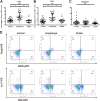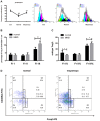Association of increased Treg and Th17 with pathogenesis of moyamoya disease
- PMID: 28596558
- PMCID: PMC5465197
- DOI: 10.1038/s41598-017-03278-8
Association of increased Treg and Th17 with pathogenesis of moyamoya disease
Abstract
Immuno-inflammation has been shown to play a pivotal role in the pathogenesis of moyamoya disease (MMD). However, how did circulating Treg/Th17 cells involve in MMD patients remains unclear. 26 MMD, 21 atherothrombotic stroke, and 32 healthy controls were enrolled in this study. MMD patients have a significantly higher percentage of circulating Treg and Th17 cells as well as their dominantly secreting cytokines than other groups (P < 0.0001), whereas no difference was found in the ratio of Treg/Th17 between patients in MMD and atherothrombotic stroke group or control subjects (P = 0.244). However, the increased Treg in MMD patients which were enriched with FrIII Treg cells had deficient suppressive functions (P = 0.0017) compared to healthy volunteers. There was a positive correlation between Treg or TGF-β and MMD Suzuki's stage. And the level of circulating Treg was as an independent factor associated with MMD stage. Besides, TGF-β was also correlated with the increased expression of VEGF in MMD patients. Our findings indicated an important involvement of circulating Treg in the pathogenic development of MMD and TGF-β in Treg induced VEGF.
Conflict of interest statement
The authors declare that they have no competing interests.
Figures


References
Publication types
MeSH terms
Substances
LinkOut - more resources
Full Text Sources
Other Literature Sources

